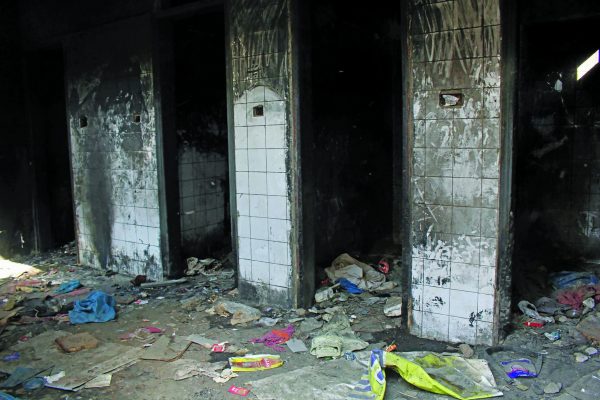Societies where open defecation is common report highest under-five child mortality
The issue of poor sanitation and open defecation is a serious public health risk in poor countries including Pakistan.
People who do not have access to proper sanitation including clean toilets and clean water to wash their hands, were exposed to various deadly but preventable diseases that are transmitted due to exposure to human faeces.
These diseases include diarrhoea, cholera, dysentery, typhoid, hepatitis A, and polio. The people were often at risk of worm infestations which, although less life-threatening than diarrhoeal diseases, weaken children and make them more susceptible to malnutrition and opportunistic infections such as pneumonia, measles, and malaria.
Malnutrition, in turn, renders children more susceptible to stunting.
Despite being largely preventable, diarrhoeal diseases were the second largest killer of children — the first being pneumonia — besides being a major contributor to malnutrition especially for women and children.
Statistics showed that the countries that lacked sanitation facilities and where open defecation was widespread had the highest under-five child mortality as well as the highest levels of malnutrition.
Since it is embarrassing and hazardous for women and girls to defecate in the open during broad daylight, they tend to drink less water so that they do not have to relieve themselves often. This puts them more at risk of developing renal problems.
A vicious cycle
The vicious cycle of disease and malnutrition reportedly incurs a heavy financial burden on families. Not only were there high medical bills to pay, which often had to be borne by families in the absence of adequate government-run health facilities, but also the issue of frequent disease impairing the individual’s capacity to earn and pushing the family further into poverty. Given its importance to health, child development and social and economic progress, in 2015, the United Nations General Assembly recognised sanitation as a human right.
It entitles everyone to sanitation services that ensure privacy, dignity and safety and that are accessible and affordable. Yet, according to the United Nations International Children’s Emergency Fund (UNICEF) report titled State of the World’s Sanitation, published in November 2020, the world was alarmingly off track to deliver sanitation for all by 2030.
Despite progress, over half the world’s population — around 4.2 billion people — use sanitation services that leave human waste untreated, threatening human and environmental health. Of these people, 673 million had no toilets at all and practice open defecation.
An estimated 367m school-age children attend schools without toilets. More than 10 per cent of healthcare facilities had no sanitation service at all. Only 32pc of displaced people had basic sanitation.
Poor sanitation not only leads to diseases but also increases the risk of sexual assault for women and girls which reportedly often resulted in lost educational opportunities. Due to the lack of access to a toilet that offers privacy, women and girls often wait until nightfall to relieve themselves and risk rape while defecating in the open.
Lost opportunities
Availability of a toilet at home reduces this risk. In the absence of proper washroom facilities at school, young girls stay at home during menstruation and miss lessons or drop out of school, which prevents them from getting basic education. It had been seen that in communities where schools had a toilet and sanitation facilities, the number of girls dropping had decreased.
Released in August 2017, the Indian movie Toilet: Ek Prem Katha highlighted the country’s toilet problem, reportedly caused by cultural and religious sentiments. The story revolves around the efforts of a man named Keshav whose wife refused to live with him because there was no toilet in his house. Keshav got one built in order to bring her back but his father was not in favour of having a toilet in his house and gets it demolished.
It was only when his mother fell and injured her hip and decried vehemently that she cannot possibly walk to the fields to relieve herself that things for the family start to change. Keshav’s mother insisted on using the partly broken toilet that her son constructed in the front yard and after much reluctance, Keshav’s father gives in, realising that a toilet was indeed a critical requirement within a household.
The rest of the story is not important here. What is important is that it deals with an important subject and presents an issue often seen in developing societies — poor sanitation and open defecation — that was relevant and affects millions of people around the world. Given the importance of sanitation, it was included in the Sustainable Development Goals (SDG) — 17 in total — that were adopted by the UN in 2015 as a universal call to action to end poverty, protect the planet, and ensure that by 2030 everyone prospered.
Goal 6 of the UN SDGs aims to ‘Ensure access to water and sanitation for all’. Target 6.2 of the SDGs states: “By 2030, achieve access to adequate and equitable sanitation and hygiene for all and end open defecation, paying special attention to the needs of women and girls and those in vulnerable situations.”
The importance of SDG 6 could be judged by the fact that it was closely linked with other SDGs. Progress in SDG 6 could possibly improve health (SDG 3) as well as school attendance (SDG 4), both of which contribute to alleviating poverty (SDG 1).
Goal 6 of the SDGs was also interlinked to Goal 5, gender equality, as provision of sanitation facilities was essential for women’s education and safety.
However, progress was slow on SDG 6 which was a factor in the achievement of other goals. In April 2020, UN Secretary General António Guterres said that slow progress in SDG 6 “was hindering progress on the 2030 agenda, the realisation of human rights and the achievement of peace and security around the world.”
Pakistan’s position
Pakistan had committed to achieving SDGs and adopted the 17 development goals in its domestic, legal and policy framework. Yet, in 2017, it was termed the seventh worst country in terms of access to basic sanitation with 42pc of its population lacking basic sanitation.
According to WaterAid, a non-governmental organisation that works for water and sanitation, Pakistan was among the top 10 countries with the greatest number of people living without access to safe water. Around 79m people lacked decent toilets; 11.5pc of the people defecate in the open and one out of three schools does not have a toilet, it stated.
About 19,500 children under five die each year from diarrhoeal diseases due to lack of sanitation while 50pc of malnutrition was associated with repeated diarrhoea or intestinal worm infections as a direct result of inadequate water, sanitation and hygiene facilities, according to data from the WaterAid website. Although Pakistan had made significant progress in improving access to basic sanitation services, experts believe that provision of water, sanitation, and hygiene was still a major challenge for the country. Unfortunately, safe drinking water and sanitation were not yet recognised as human rights in the Constitution.
Since open defecation was more prevalent in rural areas, people need to be educated about its hazards and encouraged to use toilets where available. For this, the government should start a campaign to build at least community toilets in all villages and encourage people to build one at home.
Affordability might be a problem but pooling of resources for community toilet facilities and help from various NGOs working in the field can solve the problem. It need not be too sophisticated. Simply put a basic toilet — with a pit and water tap — should be erected as a first step.
Soft loans could also be given to those who cannot build one themselves. Yet it is also true that for toilets to function properly, there needs to be a proper drainage and sewerage system in the locality and that is not possible without the government’s role and political will to resolve the issue.
At the same time there is a need to build public toilets across cities and towns for people on the move. Sometimes it is not possible to delay relieving oneself, hence, in the absence of a public toilet, many people simply relieve themselves by the roadside. Here, too, women fare poorly for obvious reasons.
While it is heartening to learn that the government adopted the SDG agenda as its national agenda and several initiatives were being taken in this regard, concerted efforts are still needed to provide sanitation facilities to all. In a country where 55m people were living below the poverty line, it is all the more important to provide proper sanitation facilities. Diseases spread by lack of sanitation also increase financial burden on poor families. If not addressed urgently, this sanitation crisis will continue to keep many citizens below the poverty line.
(The writer is a freelance journalist)




















